Soba (buckwheat noodles) is an iconic part of Japanese food culture. During the Edo period, it was consumed more frequently than sushi or tempura, making it truly the food of the common people. Today, it remains a beloved traditional dish popular among tourists. This guide will introduce you to the basics of enjoying soba in Tokyo.
Soba Basics
Types and Characteristics
Different flour ratios
- Juwari soba (100% buckwheat): Made with 100% buckwheat flour. Offers the purest flavor but breaks easily.
- Nihachi soba (80% buckwheat): Made with 80% buckwheat and 20% wheat flour. The most common type with good texture and manageability.
- Sangawari soba (30% buckwheat): Common at standing soba shops. Made with 30% buckwheat and 70% wheat flour. More affordable while still offering buckwheat flavor.
Different serving styles
- Zaru/Mori soba: Cold soba served with dipping sauce. Popular in summer.
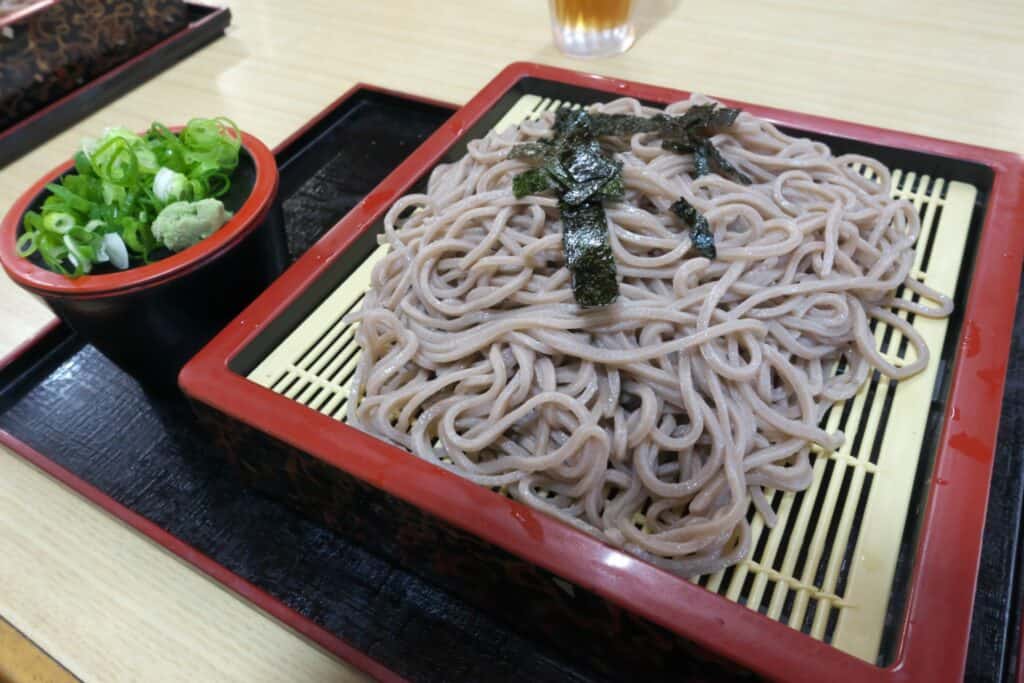
- Kake soba: Hot soba served in broth. Popular in winter.
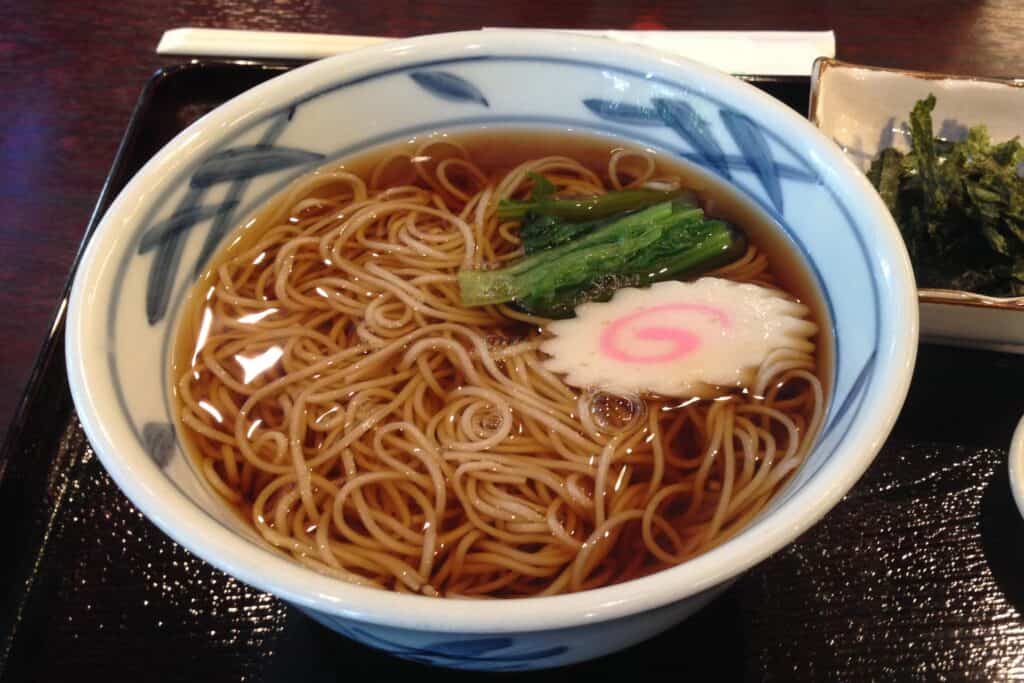
- Tororo soba: Topped with grated mountain yam. Known for its slimy texture.
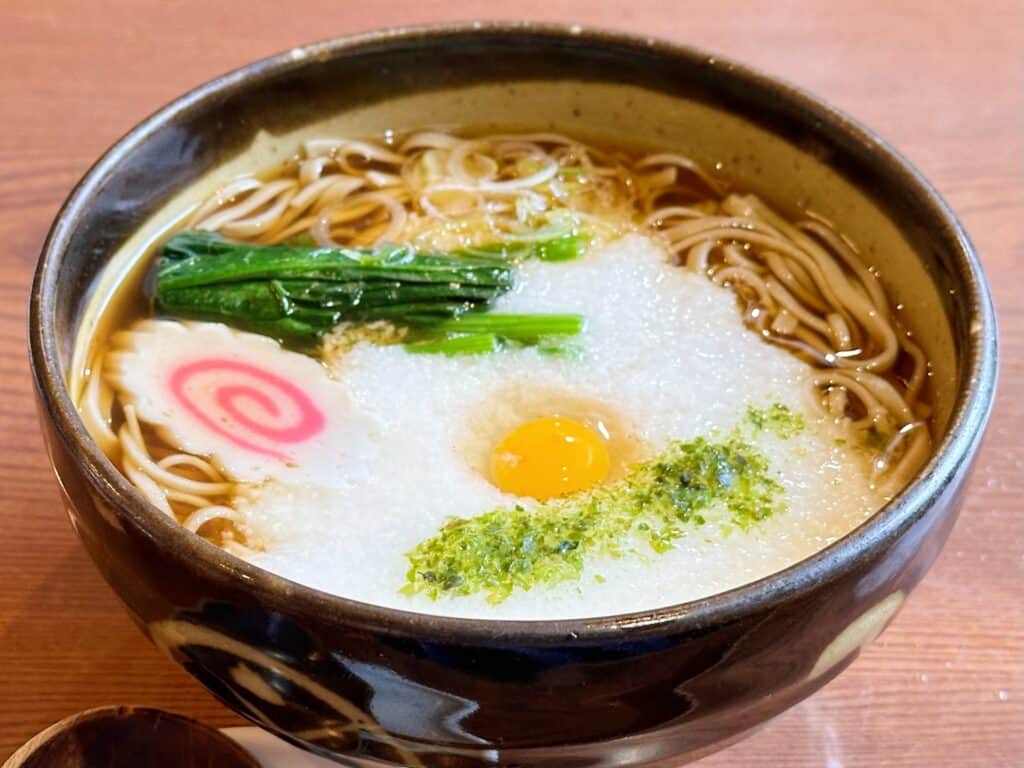
- Tempura soba: Topped with tempura. Filling and satisfying.
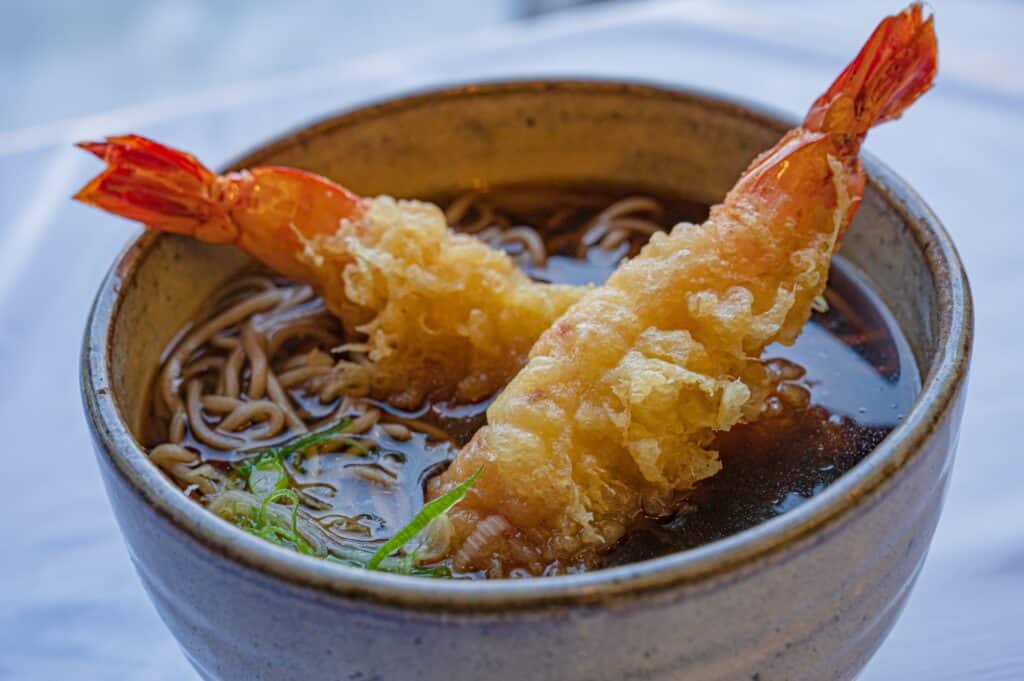
- Kamo nanban soba: Hot soba with duck meat and green onions. Winter favorite.
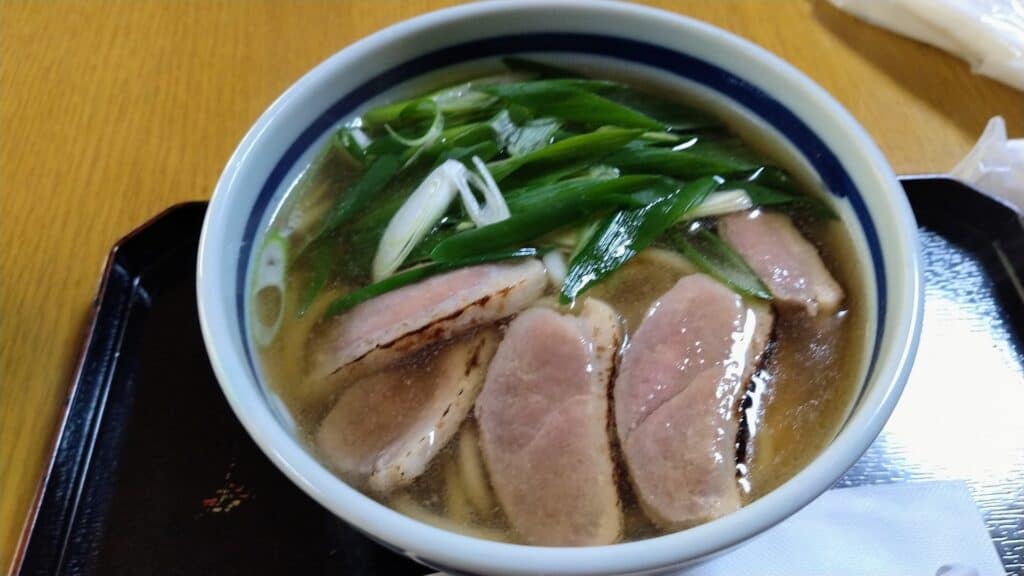
High-End vs. Standing Soba Shops
Specialty Soba Restaurants
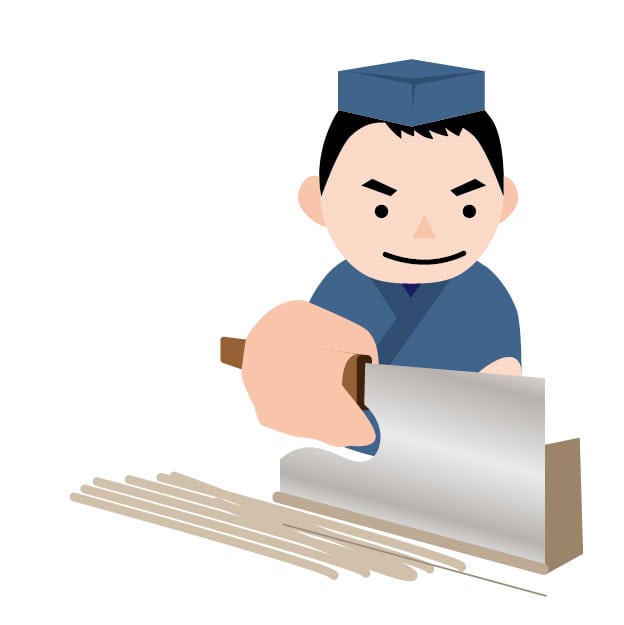
- Buckwheat ratio: 80-100% buckwheat flour
- Price range: ¥1,000-¥5,000
- Features: Artisanal methods like hand-made noodles and stone-ground flour
Standing Soba Shops

- Buckwheat ratio: 30-55% buckwheat flour
- Price range: ¥300-¥500
- Features: Quick, convenient, often found near stations and office areas
Soba Culture and Traditions
Toshikoshi Soba (New Year’s Eve Soba)
Eating soba on New Year’s Eve is a tradition dating back to the Edo period. This custom carries multiple meanings:
- Longevity wishes: The long, thin noodles symbolize a long life.
- Cutting off bad luck: Soba noodles break more easily than other noodles, symbolizing cutting off the year’s misfortunes.
- Financial fortune: In the Edo period, goldsmiths used buckwheat flour to collect gold dust, associating soba with wealth.
- Health prayers: Buckwheat’s ability to grow in harsh conditions symbolizes resilience and good health.
Sobayu (Soba Cooking Water)
“Sobayu” is the water in which soba noodles were cooked, typically mixed with the remaining dipping sauce and drunk after the meal.
- It contains vitamins and minerals that leached out from the noodles during cooking.
- During the Edo period, people believed drinking sobayu maintained good health.
- It’s still served at soba restaurants today, allowing you to enjoy soba to the very end.
Nutrition and Health Benefits
Soba is highly nutritious and beneficial for health:
- Quality protein: Rich in essential amino acids, comparable to milk protein
- B vitamins: Promotes energy metabolism and helps with fatigue recovery
- Rutin: Strengthens blood vessels and helps prevent high blood pressure and arteriosclerosis
- Dietary fiber: Improves intestinal environment and aids digestion
- Low calorie: Lower in calories compared to other noodles, suitable for dieters
About Soba Allergies
Here’s what you should know about buckwheat allergies:
- If you have a buckwheat allergy, consult your doctor before traveling to Japan
- In Japan, “soba” is one of the seven ingredients that must be labeled on restaurant menus and processed foods
- If you have an allergy, say “I have a soba allergy” before ordering
- If concerned, many restaurants also offer other types of noodles (udon, ramen)
Soba-Making Experience in Tokyo
You can try making soba noodles yourself at classes in Tokyo. Near Kappabashi (the kitchenware district) close to Asakusa, you can experience traditional Japanese noodle-making.
Recommended classes:
- Location: Around Kappabashi, near Asakusa
- Experience: Learn the entire process from kneading buckwheat flour to cutting noodles
- Duration: About 2 hours
- Booking: Available through Asoview
Preview
Tips for Enjoying Soba
- Eating technique: First dip just a small portion of the noodles in the sauce to enjoy the original flavor, then gradually increase the amount of sauce.
- Slurping sound: Making slurping sounds when eating soba is not impolite in Japan; rather, it’s a way to express enjoyment.
- Seasonal enjoyment: Cold zaru soba in summer, hot kake soba or kamo nanban in winter.
- Sauce variations: Eastern Japan (Kanto) tends to have stronger, darker sauce, while Western Japan (Kansai) prefers lighter sauce.
Tokyo’s Top 3 Soba Restaurants
The following are Tokyo’s best soba restaurants according to Tabelog, Japan’s most influential and trusted gourmet review website.
No.1: Tamawarai (玉笑)
Japan’s No.1 Soba Experience Near Takeshita Street
Tamawarai is located near the famous Takeshita Street in Harajuku. It has earned a Michelin star for five consecutive years from 2016 and continues to be featured in the Michelin Bib Gourmand. The owner personally grows the buckwheat, mills it with a stone grinder, and prepares every aspect of the soba by himself. Despite its prestigious reputation, you can enjoy Japan’s finest soba at surprisingly reasonable prices for lunch.
Restaurant Details
Essential Information
- Address: 5-23-3 Jingumae, Shibuya-ku, Tokyo (7-min walk from Meiji-jingumae Station)
- Hours: Wed-Fri 11:30-15:00, 18:30-21:30; Sat 11:30-15:00, 18:00-20:00
- Closed: Mon, Tue, Sun (Dinner is course menu only)
- Budget: Lunch from ¥1,100, Dinner (course) from ¥5,000
- Payment: Cash only
- Seiro (cold soba): ¥1,100
- Natto Seiro (cold soba with fermented soybeans): ¥1,600
- Evening course meals start from around ¥5,000
- 7-minute walk from Meiji-jingumae Station on Tokyo Metro
- 10-minute walk from JR Harajuku Station or Shibuya Station
- Diagonally across from Onden Shrine
Preview
Location
</details>
No.2: Jiyusan (じゆうさん)
Respected Soba with an Evening Sake Experience
Jiyusan has been listed in the Michelin Bib Gourmand for three consecutive years and selected as one of Tokyo’s top 100 restaurants five times. The restaurant offers reasonably priced soba along with an extensive selection of side dishes, making it perfect for enjoying sake with small plates before finishing with soba. The atmosphere is more casual than formal, with reasonable prices for its quality.
Restaurant Details
Essential Information
- Address: 3-1-4 Eharacho, Nakano-ku, Tokyo (8-min walk from Higashi-Nagasaki Station)
- Hours: Tue, Thu 11:30-14:30; Wed, Fri, Sat 11:30-14:30, 17:30-20:30
- Closed: Mon, Sun, Holidays
- Budget: Lunch ¥1,000-¥2,000, Dinner ¥6,000-¥8,000
- Payment: Credit cards, electronic money, and QR code payment accepted
- Tororo Soba (with grated yam): ¥1,600
- Kake Soba (hot soba): ¥1,100
- Various seasonal side dishes
- No reservations for lunch
- Dinner by reservation only
- Closes when soba sells out
- Make dinner reservations via their website (not by phone)
Preview
Location
No.3: Asakusa Juroku (浅草 十六)
Evening Only Izakaya-Style Soba Experience
Located in the soba kingdom of Asakusa, Juroku feels more like an izakaya (Japanese pub) with soba rather than a dedicated soba restaurant. Open only for dinner, it offers course meals featuring premium ingredients along with excellent soba. It has been selected as one of Tokyo’s top 100 restaurants six times since 2017. Note that foreign visitors are charged a ¥3,000 translation fee per person, which is an important consideration when deciding whether to visit.
Restaurant Details
Essential Information
- Address: 4-37-8 Asakusa, Taito-ku, Tokyo, Odai Building 1F (8-min walk from Asakusa Station on Tsukuba Express)
- Hours: 18:00-22:00 (Closes when soba sells out)
- Budget: ¥15,000-¥20,000
- Payment: Major credit cards accepted (VISA, Master, JCB, AMEX, Diners)
- Duck hot pot with seri (water dropwort)
- Pork cutlet using premium Akagi pork
- Seasonal ingredients from across Japan
- Foreign visitors may be charged a ¥3,000 translation fee per person, which is unfortunate but worth noting before visiting.
Preview
Location
Special Mention: Okina Soba in Asakusa
A Local Treasure: Authentic & Affordable Soba in the Heart of Asakusa
Hidden since 1914 in Asakusa’s backstreets, this soba sanctuary offers a masterclass in Tokyo’s noodle culture at astonishingly reasonable prices. Their generously portioned bowls – whether the soul-warming Curry Nanban in winter or refreshing cold Tanuki in summer – showcase why locals have kept this place their treasured secret for over a century.
What makes Okina Soba special is its combination of quality, value, and convenience. Located just seconds from Don Quijote department store, it offers much better access than Juroku (which is actually in a less convenient part of Asakusa despite its name). The restaurant is popular among Japanese celebrities and locals alike, maintaining the same affordable prices for both lunch and dinner.
Restaurant Details
Essential Information
- Specialty: Authentic soba with huge portions
- Best dishes: Curry Nanban (hot soba with duck & curry broth), Hiyashi Tanuki (cold soba)
- Exceptional value: ¥700-800 per hearty bowl
- Same prices for lunch and dinner
- No English menu, but easy ordering: Just say “Karei Nanban” or “Hiyashi Tanuki”
- Location: Seconds from Don Quijote and Yoshikami in Asakusa
Preview
Location
- Specialty: Authentic soba with huge portions
- Best dishes: Curry Nanban (hot soba with duck & curry broth), Hiyashi Tanuki (cold soba)
- Exceptional value: ¥700-800 per hearty bowl
- Same prices for lunch and dinner
- No English menu, but easy ordering: Just say “Karei Nanban” or “Hiyashi Tanuki”
- Location: Seconds from Don Quijote and Yoshikami in Asakusa
Local insight: As someone born and raised in Asakusa, I highly recommend this hidden gem for visitors looking for authentic, affordable soba in a convenient location.
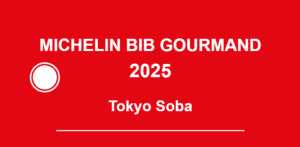

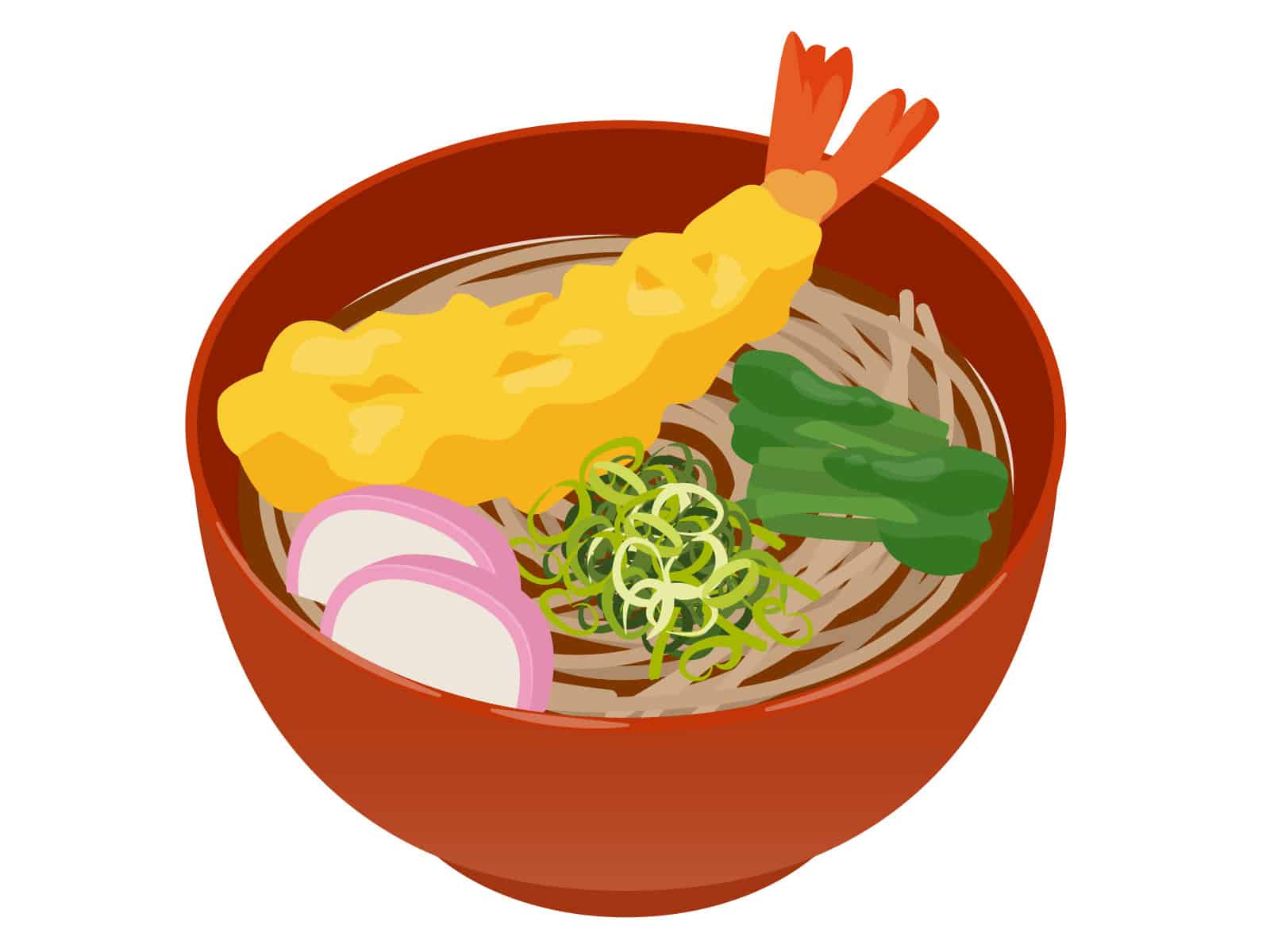
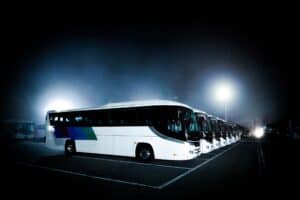
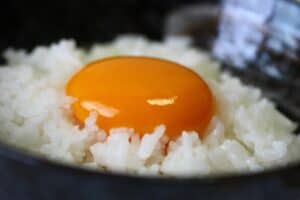

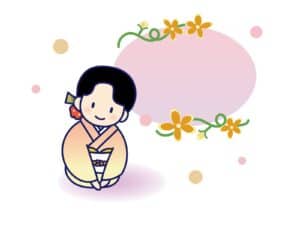
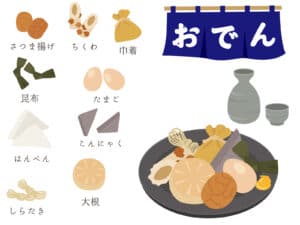

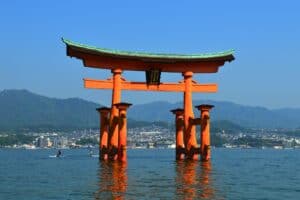
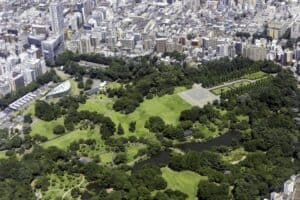
コメント
コメント一覧 (1件)
[…] Location あわせて読みたい Japanese Soba 101: Enjoying Traditional Noodles in Tokyo Soba (buckwheat noodles) is an iconic part of Japanese food culture. During the Edo period, it was […]